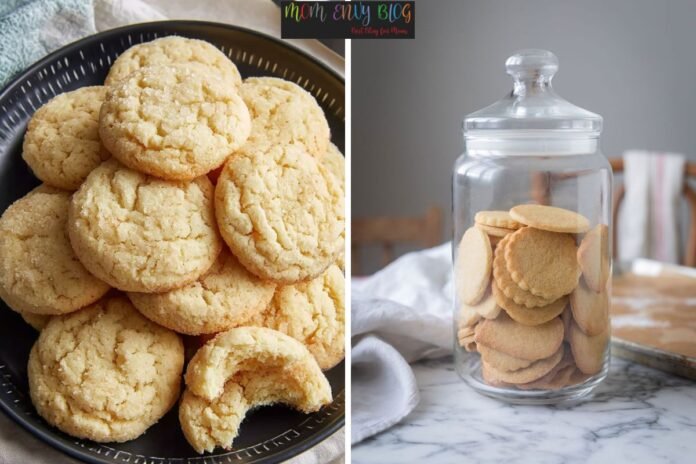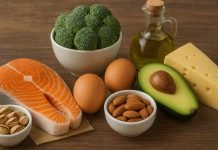Gather Core Ingredients and Understand Why Vanilla Matters
A vanilla cookie recipe is much more than a basic sugar cookie. It’s a study in balance — where butter, sugar, and flour form the texture, while pure vanilla creates the signature aroma and warmth that transforms simplicity into sophistication. The true secret of a perfect vanilla cookie lies in how quality vanilla interacts with fat and sugar during baking.
Vanilla contributes not only fragrance but also sweetness perception. Its more than 200 aromatic compounds, such as vanillin, p-hydroxybenzaldehyde, and anisaldehyde, bind with milk fats and enhance mouthfeel. This makes your cookie taste richer, even when the ingredient list looks modest.
Using real vanilla (extract, bean, or paste) can make the difference between an average cookie and one that feels luxurious. Synthetic vanillin may mimic scent but not depth, while authentic vanilla develops layered flavor tones — floral, woody, and caramel-like — as the cookie bakes.
Choose the Best Vanilla Form for Your Cookies
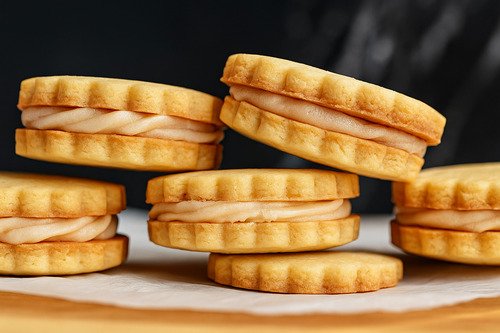
When baking vanilla cookies, the type of vanilla you choose changes not only aroma but also appearance and intensity. Bakers often underestimate this variable, yet it defines your cookie’s character.
Vanilla Extract vs Vanilla Bean vs Vanilla Paste – What’s the Difference?
| Type of Vanilla | Description | Best Use in Cookies | Flavor Strength |
| Pure Vanilla Extract | Alcohol-based solution from cured vanilla beans. Common in home baking. | Everyday cookies and drop-style doughs | Medium |
| Vanilla Bean | Whole seed pod from Vanilla planifolia; seeds visible in dough. | Premium cookies, visual specks add charm | Very High |
| Vanilla Bean Paste | Concentrated blend of extract + seeds in a syrup base. | Professional-grade cookies and frostings | High |
| Imitation Vanillin | Synthetic compound mimicking vanillin; lacks natural complexity. | Budget-friendly baking, not ideal for pure flavor | Low |
If your goal is a soft, aromatic cookie with elegant specks, use vanilla bean paste — it’s stable, strong, and easy to measure. Reserve whole beans for special occasions or shortbread-style cookies where vanilla dominates.
Combine Essential Ingredients with Precision
A successful vanilla cookie recipe depends on balancing butterfat, sugar, and flour protein. These ratios determine whether your cookie turns out chewy, tender, or crisp.
Core Ingredients (yields about 24 cookies):
| Ingredient | U.S. Measurement | Metric Equivalent |
| Unsalted butter (82% fat) | ¾ cup (1½ sticks), softened | 170 g |
| White sugar (granulated or caster) | 1 cup | 200 g |
| Large egg (room temperature) | 1 | 50–55 g |
| Pure vanilla extract or paste | 1 ½ teaspoons | 7–8 mL |
| All-purpose flour | 1 ⅔ cups | 210 g |
| Baking soda | ½ teaspoon | 2 g |
| Fine salt | ¼ teaspoon | 1 g |
| Optional for coating | 2 tablespoons granulated sugar | 25 g |
- Butter (entity) → attribute: moisture/fat ratio → value: soft crumb.
- Sugar → attribute: hygroscopic property → value: chewiness.
- Flour → attribute: gluten network → value: structure.
- Vanilla → attribute: volatile aromatics → value: depth of flavor.
Using high-fat European or New Zealand butter increases tenderness because of the lower water content. Granulated sugar provides structure, while caster sugar melts more evenly — excellent for uniform browning.
Prepare Cookie Dough for a Soft, Chewy Texture
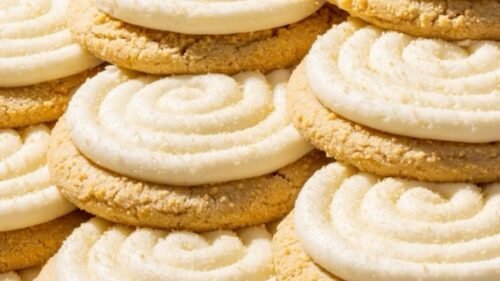 The dough’s consistency dictates whether your vanilla cookies turn soft, dense, or crisp. Begin by creaming butter and sugar to incorporate air. This forms micro-bubbles that give lightness without over-leavening.
The dough’s consistency dictates whether your vanilla cookies turn soft, dense, or crisp. Begin by creaming butter and sugar to incorporate air. This forms micro-bubbles that give lightness without over-leavening.
Next, add the egg and vanilla — the emulsifiers in egg yolk help bind fat and moisture. Finally, fold in the dry ingredients just until combined. Overmixing toughens cookies because gluten develops excessively.
For consistent results, use this order:
- Cream softened butter + sugar (3–4 minutes until pale).
- Add egg and vanilla; beat until fluffy.
- Whisk flour, salt, and baking soda separately.
- Fold dry ingredients into wet using a spatula.
- Form dough into balls (1 tbsp each for small cookies).
- Optional: Roll in sugar for sparkle.
Why Chilling Dough Matters (or Doesn’t) for Vanilla Cookies
Chilling cookie dough solidifies butter and hydrates flour. This slows spread during baking and deepens flavor. If you like thicker, chewier cookies, chill for at least 30–60 minutes. For crisp, buttery edges, bake immediately after mixing.
| Chilling Time | Result | Best For |
| 0 minutes | More spread, crisp edges | Thin cookies |
| 30 minutes | Balanced chew and shape | Standard batch |
| 2 hours | Deep vanilla flavor, soft interior | Gourmet cookies |
Follow the Step-By-Step Baking Method
Precision transforms an average recipe into a professional result. Follow these tested steps:
- Preheat oven: 180 °C / 355 °F. Line baking trays with parchment or silicone mats.
- Cream butter and sugar: Beat for 3–5 minutes until light and fluffy.
- Add egg and vanilla: Beat 2 minutes until creamy.
- Mix dry ingredients: Combine flour, salt, baking soda separately.
- Combine: Add dry to wet in two parts until dough forms.
- Shape: Scoop dough (1 tbsp ≈ 25 g) and roll into balls.
- Coat (optional): Roll in sugar for sparkle.
- Bake: Place on trays 5 cm / 2 in apart. Bake 9–11 minutes until edges set but centers are pale.
- Cool: Let rest 5 minutes on tray, then transfer to rack.
Texture & Time Matrix
| Cookie Type | Scoop Size | Bake Time | Texture Outcome |
| Small (1 tbsp) | ~25 g | 9–10 min | Crisp edge, chewy center |
| Medium (2 tbsp) | ~50 g | 13–15 min | Soft and thick |
| Chilled dough | — | +1 min | Reduced spread, deeper flavor |
Adjust Texture and Shape: Soft vs Crisp Vanilla Cookies
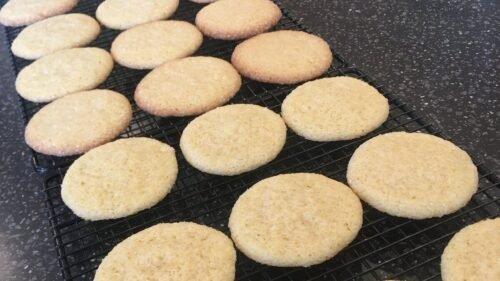
Texture is chemistry. Sugar ratio, butter temperature, and baking time all dictate results.
To achieve soft, chewy vanilla cookies, maintain high moisture retention:
- Use slightly under-baked centers.
- Replace 2 tbsp of granulated sugar with light brown sugar for hygroscopic molasses.
- Chill the dough.
For crisp vanilla cookies, flatten dough balls before baking and extend bake time by 1–2 minutes. Reducing moisture (use melted butter or less egg) also encourages snap.
| Variable | Soft Cookie | Crisp Cookie |
| Butter form | Softened | Melted |
| Sugar type | Mix of white & brown | All white |
| Bake time | Shorter | Longer |
| Chilling | Yes | Optional |
| Result | Thick, chewy | Thin, crunchy |
Create Popular Variations and Customisations
Once you master the base dough, flavor innovation becomes endless. Vanilla’s neutrality pairs beautifully with almost any sweet profile.
Frosted Vanilla Cookies
Top cooled cookies with buttercream or royal icing. Add vanilla bean paste to frosting for double-vanilla intensity.
Vanilla Bean Sugar Cookies
Roll dough in fine sugar before baking — creates sparkly surfaces perfect for holidays.
Add-Ins & Infusions
- White chocolate chips for creamy contrast
- Lemon zest for brightness
- Toasted coconut for tropical aroma
- Crushed almonds or pistachios for texture
Vegan or Gluten-Free Variants
Use vegan butter (80% fat minimum) and a flax-egg (1 tbsp flax + 3 tbsp water). Replace flour with a 1:1 gluten-free baking mix containing xanthan gum. Expect slightly more spread; chill dough longer.
Source High-Quality Ingredients and Tools
Quality drives consistency. Seek single-origin vanilla (Madagascar, Tahiti, Mexico) for authentic complexity.
Recommended tools:
- Digital scale for precise ratios.
- Cookie scoop (1 tbsp or 2 tbsp).
- Stand mixer with paddle attachment.
- Silicone baking mats for even heat.
- Oven thermometer for temperature accuracy.
Ingredient sourcing tips:
| Ingredient | Best Type | Why It Matters |
| Vanilla | Single-origin, pure extract or paste | Complex aroma |
| Butter | 82% butterfat, cultured | Richer flavor |
| Sugar | Fine caster sugar | Better creaming and spread |
| Flour | 10–11% protein | Balanced structure |
Avoid Common Mistakes When Baking Vanilla Cookies
- Over-mixing the dough → results in tough cookies. Stop as soon as flour disappears.
- Incorrect butter temperature → too warm causes spreading; too cold prevents creaming.
- Skipping chilling (for chewy cookies) → dough spreads unevenly.
- Baking too long → residual heat finishes the bake; remove when edges are set.
- Using artificial vanilla → yields flat aroma; always opt for pure extract or paste.
Match the Right Vanilla Cookie Recipe to the Occasion
| Occasion | Best Cookie Style | Serving Suggestion |
| Holiday Gifting | Roll-in-sugar vanilla cookies | Pack in tins with ribbon |
| Afternoon Tea | Thin, crisp vanilla biscuits | Pair with Darjeeling or Earl Grey |
| Children’s Baking | Soft drop cookies | Fun to decorate with sprinkles |
| Dessert Platters | Frosted or filled cookies | Combine with chocolate drizzles |
| Breakfast Treat | Thick chewy vanilla cookie | Ideal with coffee or milk |
Watch Emerging Trends in Vanilla Cookie Recipes
The vanilla cookie is evolving with culinary innovation:
- Single-origin vanilla beans gaining attention for terroir flavor notes.
- Low-sugar variants using monk fruit or coconut sugar.
- Air-fryer vanilla cookies rising among quick-bake enthusiasts.
- High-protein vanilla cookies for fitness-focused bakers.
- Fermented butter and cultured dairy adding tangy depth.
These trends reflect how even the simplest cookie adapts to modern palates and technology while keeping its nostalgic essence.
Myth-Busting: Does More Vanilla Mean Better Cookies?
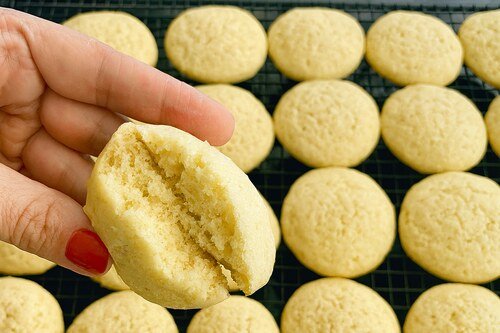
Not necessarily. Excess vanilla can overwhelm butter and sugar nuances.
Optimal flavor concentration sits around 0.5–1% of total dough weight. Beyond this, alcohol from extract may alter texture and bitterness.
Pro Tip: Layer flavor — add a small portion of vanilla paste during creaming and another touch after mixing the dry ingredients. This retains aroma through the bake cycle.
Storage and Freezing Instructions
- Room Temperature: Store in an airtight tin up to 7 days.
- Frozen Cookies: Up to 3 months; thaw at room temperature.
- Frozen Dough Balls: Bake straight from frozen, adding 1 minute to bake time.
To retain that pure vanilla perfume, insert a piece of vanilla bean or vanilla sugar sachet in the storage jar.
Conclusion
A truly great vanilla cookie celebrates simplicity elevated through precision. When butter, sugar, and flour harmonize under the fragrance of real vanilla, the result is nostalgic yet sophisticated. Whether chewy, crisp, or festively frosted, this recipe is your foundation for countless variations. With both metric and U.S. measures included, bakers worldwide can enjoy this universally loved classic — soft, golden, and filled with the comforting essence of pure vanilla.
FAQs
- What makes a vanilla cookie different from a sugar cookie?
Vanilla cookies use a higher proportion of pure vanilla and butter, creating deeper aroma and chew, while sugar cookies emphasize shape and decoration. - Can I use vanilla extract instead of a vanilla bean?
Yes, 1 teaspoon extract = seeds of ½ vanilla bean. Paste offers similar strength with visible specks. - Why did my vanilla cookies spread too much?
Butter may have been too soft or dough under-chilled. Add 10–15 minutes chilling time or increase flour by 1 tablespoon. - How can I make my cookies softer and chewier?
Slightly under-bake, add a bit of brown sugar, and store in an airtight container with a slice of bread to retain moisture. - Is it better to chill the dough before baking?
For thicker cookies and developed flavor, yes. For thin, crisp edges, skip chilling. - How should I store vanilla cookies to maintain flavor?
Keep in airtight tins away from strong odors. Add vanilla sugar or a bean pod for long-term aroma retention. - Can I make vegan or gluten-free vanilla cookies?
Absolutely. Use plant butter (80% fat) and a gluten-free flour blend with xanthan gum. Chill longer to offset structure differences. - Does using synthetic vanillin instead of real vanilla bean matter?
Yes. Synthetic vanillin delivers one-dimensional sweetness but lacks the complex floral, smoky, and creamy undertones of natural vanilla. - What occasions are vanilla cookies best for?
They’re ideal for holiday gifting, bake sales, and cozy tea-time treats — universally appealing and endlessly customizable.
Read Also:










